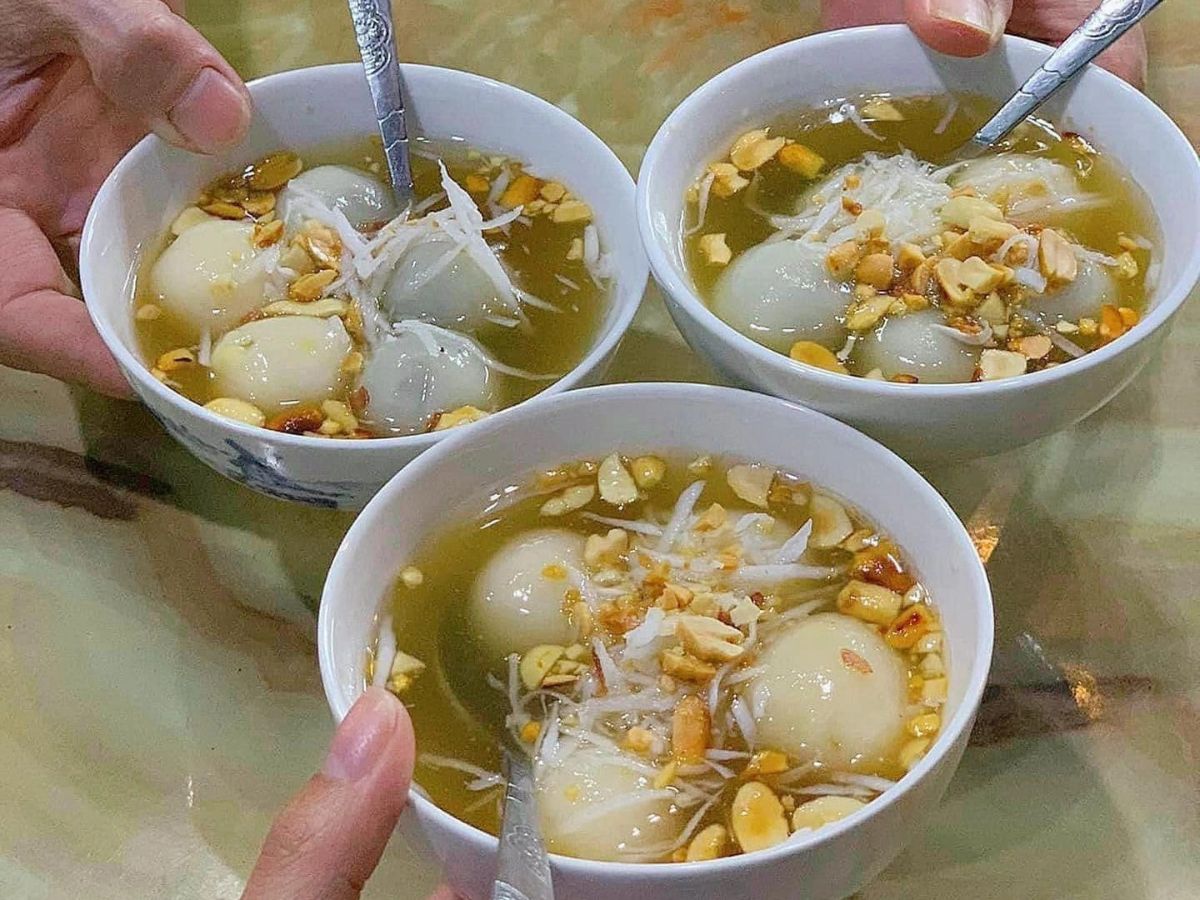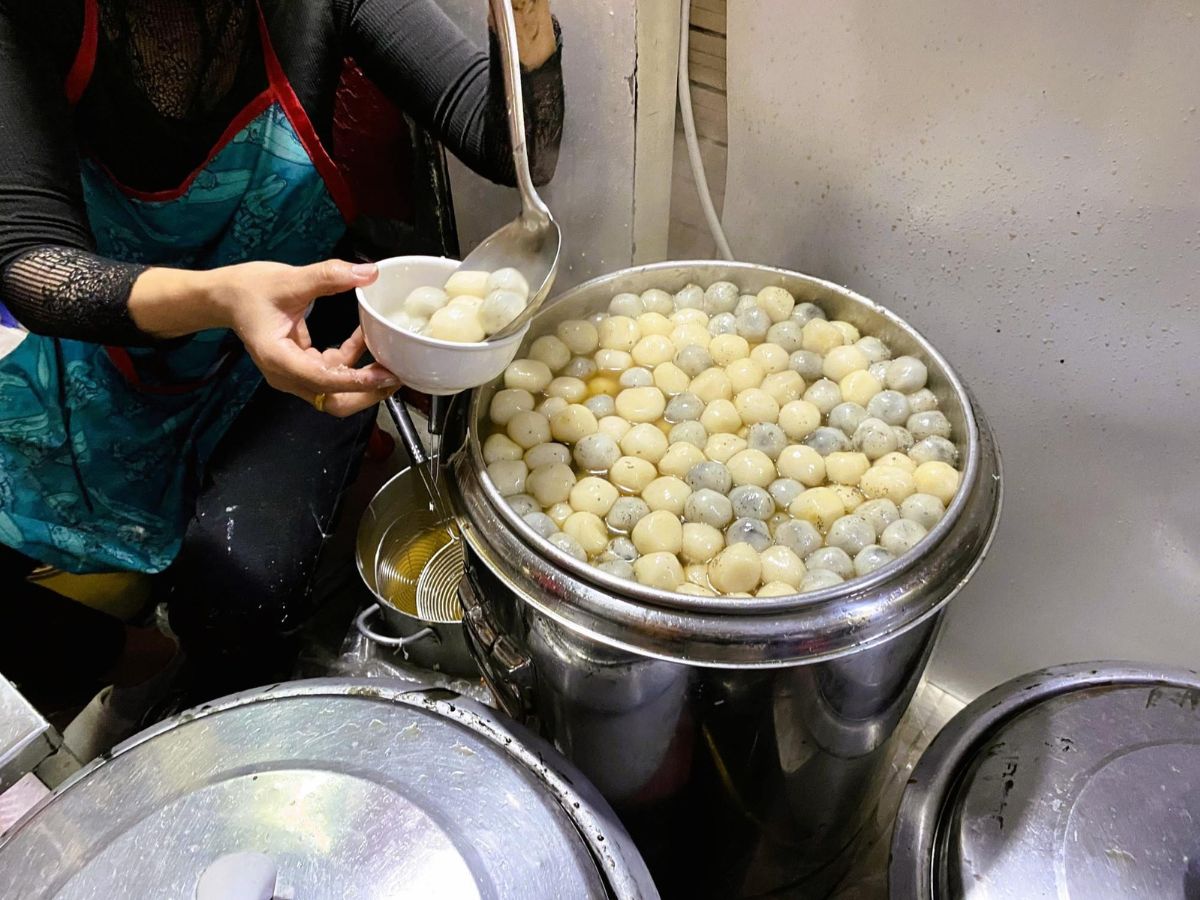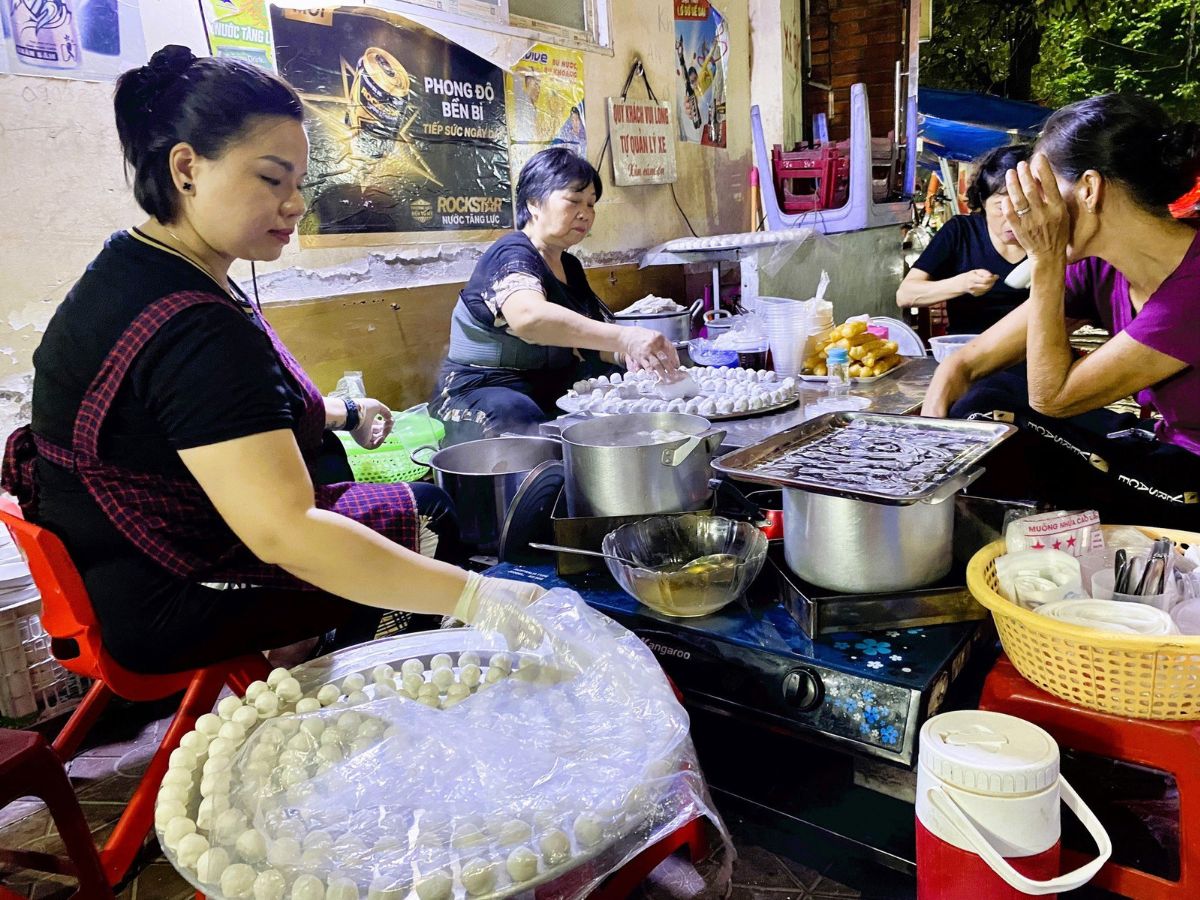1. What is Hai Phong's Sui din?

Sui din Hai Phong is an attractive specialty dish. (Source: Collected)
Sui din Hai Phong originated from the Chinese community who migrated to the port city in the early 20th century. This dish is a unique variation of the traditional Chinese 'che troi nuoc' (sweet glutinous rice balls), brought and developed by the Cantonese people in Hai Phong.
The name "sui din" originates from Cantonese, meaning "round balls cooked in water". Over time, through cultural exchange and pronunciation changes, this name has become an icon associated with the people of Hai Phong. Sui din is not only a delicious dessert but also a vivid testament to the culinary fusion between the Chinese and Vietnamese communities in the port city.
In the culinary heritage of Hai Phong, sui din stands out as a unique cultural symbol, especially appealing towards the end of the year. This dish appears on streets everywhere, from street vendor carts to familiar family eateries, creating an unforgettable traditional flavor.
2. Ingredients, preparation, and characteristics of Hai Phong's sui din

Hai Phong sui din is a traditional culinary essence. (Source: Collected)
Hai Phong sui din is not only a rustic dish but also a culinary essence preserved through generations. From familiar ingredients to meticulous preparation, every detail contributes to creating a distinctive flavor that leaves diners unforgettable.
2.1. Main ingredients that create Hai Phong sui din
Hai Phong sui din stands out thanks to the sophisticated combination of traditional ingredients. The cake wrapper is made from fragrant glutinous rice flour, choosing large, round, and chewy grains. After soaking thoroughly, grinding finely, and filtering clean, the glutinous rice flour is kneaded with warm water mixed with a little salt, creating a perfectly soft and chewy texture.
The filling is the key element that creates the distinctive flavor. Toasted black sesame seeds are combined with crushed roasted peanuts and fresh shredded coconut, adding granulated sugar or palm sugar to create a naturally sweet and nutty taste. Some places also offer variations with white sesame seeds or mung beans, bringing a diverse flavor experience.
The broth of sui din is also very special. Fresh ginger is gently simmered with palm sugar or sugarcane molasses to create a subtly sweet flavor mixed with a hint of warm spiciness. When served, fresh shredded coconut and roasted peanuts sprinkled on top make the dish richer and more appealing, captivating anyone who tries it for the first time.
2.2. Traditional preparation and new variations
Preparing Hai Phong sui din according to the traditional recipe requires skill and patience. After kneading the soft glutinous rice dough, the maker divides it into small portions, about 3–4 cm in diameter. The dough portions are flattened, the filling is placed in the center, and then skillfully rolled into a ball to seal the cake, preventing the filling from leaking during boiling.
When cooking, the sui din balls are dropped into boiling water, boiled until they float to the surface, then removed into cold water to maintain their chewiness and prevent them from breaking. The ginger syrup is simmered over low heat, seasoned moderately, creating a characteristic warm, spicy, and subtly sweet flavor.
Nowadays, many eateries in Hai Phong have created new versions of sui din. Besides the traditional filling, diners can enjoy purple taro, mung bean, or chocolate fillings. Some places also use magenta leaves and butterfly pea flowers to create natural colors for the cake wrapper, making the dish more visually appealing and attractive.
3. Distinguishing Hai Phong sui din from Banh troi tau

The attractive black sesame filling of Hai Phong's sui din. (Source: Collected)
Although they look similar, Hai Phong's sui din and banh troi tau possess distinct flavors and identities. The subtle differences in ingredients, preparation methods, and tasting experience create the unique, unmistakable character of each dish.
3.1. Comparing fillings and broth
Many people often mistake Hai Phong's sui din and banh troi tau as two different dishes, but in reality, they are the same dish. Banh troi tau originates from China, and upon its introduction to Vietnam, it was adapted to suit Vietnamese palates. Over time, this dish has been called by various names in different regions, with Hai Phong's sui din being a version that strongly reflects local characteristics, standing out with its sweet, rich flavor, the pungent spiciness of ginger, and the fragrant, nutty aroma of sesame and roasted peanuts.
The filling of sui din mainly consists of black sesame, roasted peanuts, and grated coconut, creating its characteristic rich and nutty flavor. In contrast, banh troi tau typically uses a mung bean filling, sometimes with a little sesame, but it's not as rich as sui din. The sizes also differ: sui din are small, about 2–4 cm, while banh troi tau are larger and softer when eaten.
3.2. When to choose sui din, and when to eat banh troi tau?
Enjoying Hai Phong's sui din on cool afternoons in the heart of the port city brings warmth and comfort to both body and soul, especially after a day of sightseeing and exploration. The mild spiciness of ginger combined with the rich, nutty sesame filling satisfies diners from the very first bite.
Conversely, banh troi tau is often served as a light dessert, particularly suitable for family meals or during holidays and Tet. The mung bean filling combined with coconut milk creates a refreshing, gently sweet sensation that is light and not cloying.
When visiting Hai Phong, tourists should not miss the opportunity to enjoy sui din at famous eateries like Dong Dung, Ky Dong, or Cau Dat to fully experience its characteristic flavor. In Hanoi, long-standing banh troi tau shops in the Old Quarter will offer a completely different experience, helping you clearly distinguish between these two traditional dishes.
4. The value, perception, and special significance of Hai Phong's sui din

Sui din Hai Phong carries deep meaning in the culinary culture of the Port City. (Source: Collected)
Sui din Hai Phong is not just a rustic dish but also contains cultural values, emotions, and deep meaning. Each steaming bowl of sui din not only evokes delicious flavors but also brings a warm, familiar feeling – as a symbol of togetherness and happiness in the culinary culture of the Port City.
4.1. Experiencing the Flavor: Nutty, warm spicy, fragrant ginger broth
When enjoying a steaming bowl of sui din Hai Phong, the aroma spreading from the wisps of steam makes diners feel instantly warm. The soft, chewy cake balls melt in the mouth, harmonizing with the rich, nutty taste of roasted sesame, peanuts, and grated coconut, creating a refined culinary experience. The filling is perfectly seasoned, not too sweet, balancing the overall flavor.
The highlight of the dish lies in the hot ginger broth, with its mild, gradually spreading spiciness, bringing a comfortable and warming sensation. Palm sugar is skillfully prepared, just sweet enough, blending with fresh ginger to create a rich flavor without being cloying.
Sui din Hai Phong always captivates diners from the very first taste, becoming an unmissable dish on the journey to explore the unique cuisine of the port city.
4.2. Meaning and Occasions Associated with Sui din Hai Phong
Sui din Hai Phong is not only a traditional dish but also carries unique cultural values, symbolizing completeness, happiness, and abundance for the Chinese community in the port city. According to ancient beliefs, regularly enjoying sui din brings good luck and prosperity in daily life.
During major holidays such as Lunar New Year, Mid-Autumn Festival, or ancestor memorial days, sui din always appears on the feast table as a meaningful dish. The pure white color of the cake wrapper symbolizes purity, while the filling represents completeness and fulfillment. The act of offering sui din is also considered a prayer for peace, prosperity, and happiness for the family.
Today, sui din Hai Phong not only plays a spiritual role but also serves as a bond connecting generations within families. Many mothers still pass down the craft of making sui din to their children and grandchildren, creating warm moments of togetherness and contributing to the preservation of the port city's unique cultural heritage.
5. Top Places to Buy Delicious Sui din Hai Phong in 2025
If you are a fan of warm, fragrant winter dishes, then sui din Hai Phong is definitely an unmissable choice. Here is a list of the best sui din eateries in 2025, highly rated by locals and tourists for their traditional flavors, reasonable prices, and friendly atmosphere.
5.1. Dong Dung Sui Din Eatery - Famous in Hai Phong

Dong Dung sui din eatery is loved by many tourists. (Source: Collected)
Address: located at 163 Cau Dat ward, Hai Phong city
Reference opening hours: 9 AM – 9 PM
Reference price: 15,000 VND/bowl
Dong Dung sui din eatery, located at 163 Cau Dat ward, is a famous sui din spot loved by many Hai Phong locals. The eatery is open from 9 AM to 9 PM with a price of only 15,000 VND per bowl. Each sui din ball is handcrafted, maintaining its chewy texture and beautiful, uniform shape.
Dong Dung's highlight is its ginger broth made from fresh Sa Pa ginger, creating a mild, warm spicy flavor. The filling combines Nghe An black sesame, Hai Duong roasted peanuts, and fresh shredded coconut, offering a harmonious nutty and rich taste. Although the eatery's space is simple, it is always crowded, especially on weekend afternoons.
5.2. Ky Dong sui din
Address: located at 34 Ky Dong street, Hai Phong city
Reference opening hours: 6 PM – 10 PM
Reference price: 10,000 – 15,000 VND/bowl
Ky Dong sui din eatery, located at 34 Ky Dong street, is open from 6 PM to 10 PM with prices ranging from 10,000 to 15,000 VND per bowl. The eatery's specialty is its traditional ginger syrup, preserved through three generations, offering a subtly sweet and gently warm spicy flavor.
Sui din at Ky Dong are small and delicate, with thin, soft wrappers and rich fillings, ensuring freshness as each batch is boiled separately. Visitors should arrive early to avoid waiting, especially on weekend evenings.
5.3. Co Ut sui din – Cau Dat

Co Ut's Sui Din Eatery is a familiar address for locals. (Source: Collected)
Address: located on Cau Dat street, Ngo Quyen district, Hai Phong city
Reference opening hours: 10 AM – 10 PM
Reference price: 15,000 VND/bowl
Co Ut's Sui Din Eatery is located on Cau Dat street, Ngo Quyen district, opens from 10 AM to 10 PM with a price of 15,000 VND per bowl. Each sui din ball is handcrafted by Co Ut, perfectly shaped and visually appealing, retaining its chewy and fragrant texture.
The highlight of the eatery is its variety of toppings such as fresh shredded coconut, roasted peanuts, and sometimes coconut milk for a rich, attractive flavor. The eatery's space is neat and clean, ideal for young groups wanting to enjoy the traditional Hai Phong sui din flavor.
5.4. To Hieu Sui Din Cake Eatery
Address: located in the 5-story collective housing area on To Hieu street, Hai Phong city
Reference opening hours: 8 AM – 10:30 PM
Reference price: 15,000 VND/bowl
To Hieu Sui Din Eatery is located in the 5-story collective housing area on To Hieu street, opens from 8 AM to 10:30 PM with a price of 15,000 VND per bowl. With nearly 20 years of experience, the eatery stands out by preserving the original Chinese recipe, offering a rich and unforgettable flavor.
The ginger broth has a characteristic honey-yellow color, simmered over low heat to preserve its delicate aroma. The filling combines black sesame and peanuts in a standard ratio, creating a balanced nutty and fatty taste. The cakes are served piping hot, especially appealing on cool days, making it an ideal destination for Hai Phong food enthusiasts.
5.5. Hang Kênh Hai Phong Sui Din Eatery
Address: located at 274 Hang Kênh street, Hai Phong city
Reference opening hours: 2 PM – 11 PM
Reference price: 10,000 – 20,000 VND/bowl
The sui din eatery at 274 Hang Kênh opens from 2 PM to 11 PM, with prices ranging from 10,000 to 20,000 VND per bowl. The space is spacious and airy, providing comfort for customers while enjoying their meal.
Besides the traditional version, the eatery also serves sui din with taro and mung bean fillings in various eye-catching colors. Notably, for 20,000 VND, customers can enjoy a sui din bowl with multiple toppings combined with a rich ginger broth, creating a unique flavor. This is an ideal spot for those who want to explore the creative variations of Hai Phong sui din .
6. Guide to making authentic Hai Phong Sui Din at Home

How to make Hai Phong Sui Din is quite simple. (Source: Collected)
If you love the sweet and warm flavor of Hai Phong Sui Din and want to make it yourself at home, preparing this dish is not too difficult. Just prepare the ingredients carefully and follow the correct steps, you will easily create a chewy, fragrant bowl of Sui Din with a spicy ginger flavor – true to the traditional taste of the Port City.
6.1. Instructions for making traditional Hai Phong Sui Din
To make Hai Phong Sui Din at home, the first step is to choose fragrant round-grained glutinous rice, soak it in diluted salt water for 4–6 hours, then grind it into a fine powder. The glutinous rice flour is then mixed with warm water in the appropriate ratio, kneaded thoroughly until soft, pliable, not sticky, and easy to shape.
The filling consists of fragrant roasted black sesame seeds, finely ground; roasted peanuts, coarsely crushed to retain crispness; and fresh shredded coconut mixed with sugar, simmered over low heat until the mixture combines well, seasoned to a pleasant sweetness. When shaping the cakes, divide the dough into equal portions, flatten them, place the filling in the center, and seal them tightly, ensuring the filling does not leak out during boiling. The cakes are then dropped into boiling water, boiled until they float, then removed and soaked in cold water to maintain perfect chewiness.
6.2. Notes on preparing and preserving at home
To ensure the homemade Hai Phong Sui Din retains its traditional flavor, the preparer needs to pay attention from ingredient selection to post-cooking preservation. A few small but important tips below will help you achieve a delicious, soft, chewy, and authentic taste like from the shops.
When making Hai Phong Sui Din at home, choosing fresh and clean ingredients is crucial. Glutinous rice should be chosen for even, fresh grains, free from mold, to make the cakes smooth and chewy. Black sesame seeds and peanuts need to be roasted evenly until golden, avoiding burning, to preserve their characteristic nutty aroma.
The ginger sugar syrup is carefully prepared using fresh, peeled, and crushed ginger, simmered with sugar over low heat for about 15–20 minutes. Do not simmer for too long to prevent the syrup from becoming too thick, while preserving the mild warm spiciness of the ginger.
Regarding preservation, after boiling, Sui Din should be soaked in cold water, then stored in the refrigerator for 1–2 days. The ginger sugar syrup should be stored separately and reheated before serving. When serving, simply scoop the cakes into a bowl, pour hot ginger syrup over them, and sprinkle with your favorite toppings to fully experience the characteristic flavor of Hai Phong Sui Din.
7. Tips for tourists eating Hai Phong Sui Din

Travel to Cat Ba Island by Sun World cable car. (Source: Collected)
When enjoying Hai Phong sui din, visitors should note some tips for a complete and convenient experience.
Popular eateries are often crowded in the evenings and on weekends, so it's best to go early or contact them in advance to avoid long waits.
The ideal times to enjoy are around 3 PM – 5 PM or after 9 PM, when the atmosphere is quieter and more comfortable.
If it's your first time trying sui din, order a moderate portion to fully appreciate its fragrant and savory taste.
For those allergic to peanuts, sesame, or coconut, ask carefully about the ingredients before ordering.
Besides cuisine, visitors can combine their trip with visits to prominent tourist attractions around Hai Phong. An attractive suggestion is to travel to Cat Ba Island by Sun World cable car, taking only about 15 minutes from the mainland. It's both quick and offers a chance to fully admire Lan Ha Bay, the undulating limestone islands, and the clear blue sky. On the island, you can swim, kayak, participate in water sports, and enjoy specialty cuisine with fresh Cat Ba seafood.
Amidst the chilly weather of the year-end days, Hai Phong sui din is a heartwarming treat that is unforgettable for anyone who has tasted it. The chewy aroma of glutinous rice flour, the refreshing sweetness of ginger water, and the rich nuttiness of roasted sesame seeds blend together to create the unique appeal of this rustic dish. If you have the chance to visit the Port City in autumn – winter, don't forget to try Hai Phong sui din to fully experience the culinary essence and the simple, close-knit culture of the people here.







